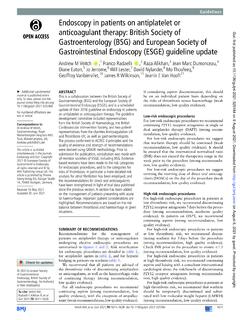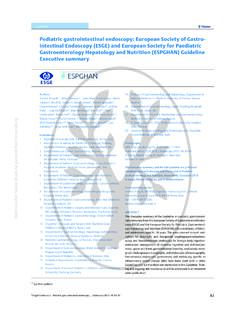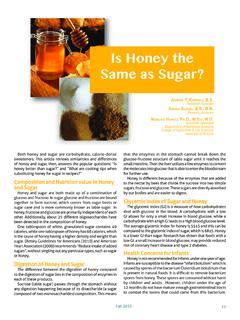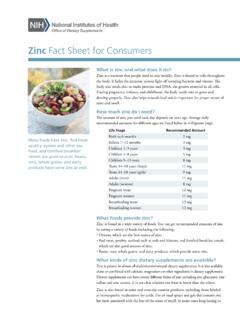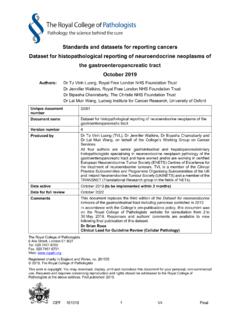Transcription of Guidelines Diagnosis and management of acute lower ...
1 1 Oakland K, et al. Gut 2019;0:1 14. and management of acute lower gastrointestinal bleeding: Guidelines from the British Society of GastroenterologyKathryn Oakland, 1 Georgina Chadwick,2 James E East,3 Richard Guy,4 Adam Humphries,5 Vipul Jairath,6,7 Simon McPherson,8 Magdalena Metzner,9 A John Morris,10 Mike F Murphy,11 Tony Tham,12 Raman Uberoi,13 Andrew McCulloch Veitch,14 James Wheeler,15 Cuthbert Regan,16 Jonathan Hoare17To cite: Oakland K, Chadwick G, East JE, et al. Gut Epub ahead of print: [please include Day Month Year]. Additional material is published online only. To view please visit the journal online (http:// dx. doi. org/ 10. 1136/ gutjnl- 2018- 317807).For numbered affiliations see end of toDr Jonathan Hoare, Department of Gastroenterology, Imperial College Healthcare NHS Trust, London, UK; j. hoare@ ic. ac. ukReceived 26 October 2018 Revised 7 January 2019 Accepted 16 January 2019 Author(s) (or their employer(s)) 2019.
2 No commercial re-use. See rights and permissions. Published by is the first UK national guideline to concentrate on acute lower gastrointestinal bleeding (LGIB) and has been commissioned by the Clinical Services and Standards Committee of the British Society of Gastroenterology (BSG). The Guidelines Development Group consisted of representatives from the BSG Endoscopy Committee, the Association of Coloproctology of Great Britain and Ireland, the British Society of Interventional Radiology, the Royal College of Radiologists, NHS Blood and Transplant and a patient representative. A systematic search of the literature was undertaken and the quality of evidence and grading of recommendations appraised according to the GRADE(Grading of Recommendations Assessment, Development and Evaluation) methodology. These Guidelines focus on the Diagnosis and management of acute LGIB in adults, including methods of risk assessment and interventions to diagnose and treat bleeding (colonoscopy, computed tomography, mesenteric angiography, endoscopic therapy, embolisation and surgery).
3 Recommendations are included on the management of patients who develop LGIB while receiving anticoagulants (including direct oral anticoagulants) or antiplatelet drugs. The appropriate use of blood transfusion is also discussed, including haemoglobin triggers and lisT oF reCommendATions1. We suggest that patients presenting with lower gastrointestinal bleeding (LGIB) are strati-fied as unstable or stable (unstable defined as a shock index >1). Stable bleeds should then be categorised as major or minor, using a risk assessment tool such as the Oakland score (weak recommendation, moderate quality evidence).2. We recommend that patients presenting with a minor self-terminating bleed (such as those with an Oakland score 8 points), with no other indications for hospital admission can be discharged for urgent outpatient investiga-tion (strong recommendation, moderate quality evidence).
4 3. We recommend that patients with a major bleed should be admitted to hospital for colonoscopy on the next available list (strong recommenda-tion, moderate quality evidence).4. We recommend that if a patient is haemody-namically unstable or has a shock index (heart rate/systolic BP) of >1 after initial resuscita-tion and/or active bleeding is suspected, CT angiography provides the fastest and least in-vasive means to localise the site of blood loss before planning endoscopic or radiological therapy (strong recommendation, low quality evidence).5. As LGIB associated with haemodynamic insta-bility may be indicative of an upper gastroin-testinal bleeding source, we recommend that an upper endoscopy should be performed im-mediately if no source is identified by initial CT angiography (CTA). If the patient stabilises after initial resuscitation, gastroscopy may be the first investigation (strong recommendation, low quality evidence).
5 6. Where indicated, catheter angiography with a view to embolisation should be performed as soon as possible after a positive CTA to maxi-mise chances of success. In centres with a 24/7 interventional radiology service, this should be available within 60 min for haemodynamically unstable patients (strong recommendation, low quality evidence).7. We recommend that no patient should proceed to emergency laparotomy unless every effort has been made to localise bleeding by radio-logical and/or endoscopic modalities, except under exceptional circumstances (strong rec-ommendation, low quality evidence).8. We recommend that in patients who are clini-cally stable but may need red blood cell (RBC) transfusion, restrictive RBC thresholds (Hb trigger 70 g/L and a Hb concentration target of 70 90 g/L after transfusion) should be used, unless the patient has a history of cardiovas-cular disease, in which case a trigger of 80 g/L and a target of 100 g/L should be used (strong recommendation, low quality evidence).
6 9. We recommend interrupting warfarin ther-apy at presentation (weak recommendation, low quality evidence). In cases of unstable gastrointestinal haemorrhage, anticoagulation should be reversed with prothrombin complex 2 Oakland K, et al. Gut 2019;0:1 14. and vitamin K (strong recommendation, moder-ate quality evidence). For patients with low thrombotic risk, warfarin should be restarted at 7 days after haemorrhage (strong recommendation, low quality evidence).10. In patients with high thrombotic risk (ie, prosthetic metal heart valve in mitral position, atrial fibrillation with pros-thetic heart valve or mitral stenosis, <3 months after venous thromboembolism), we recommend that low molec-ular weight heparin treatment be considered at 48 hours after haemorrhage (strong recommendation, low quality evidence).11. We suggest that aspirin for primary prophylaxis of cardio-vascular events should be permanently discontinued (weak recommendation, low quality evidence).
7 12. We recommend that aspirin for secondary prevention is not routinely stopped. If it is stopped, it should be restarted as soon as haemostasis is achieved (strong recommendation, moderate quality evidence).13. We recommend that dual antiplatelet therapy with a P2Y12 receptor antagonist and aspirin is not routinely stopped in patients with coronary stents in situ, and management should be in liaison with a cardiologist (strong recommenda-tion, moderate quality evidence). In unstable haemorrhage we recommend continuing aspirin if the P2Y12 receptor antagonist is interrupted (strong recommendation, moderate quality evidence). P2Y12 receptor antagonist therapy should be reinstated within 5 days (strong recommendation, moderate quality evidence).14. We recommend interrupting direct oral anticoagulant therapy at presentation (strong recommendation, low quality evidence).
8 We recommend considering treatment with inhibitors such as idarucizumab or andexanet for life-threatening haemorrhage on direct oral anticoagulants (strong recommendation, moderate quality evidence). We suggest restarting direct oral anticoagulant drug treatment at a maximum of 7 days after haemorrhage (weak recom-mendation, very low quality evidence).15. All hospitals should have a GI bleeding lead and agreed pathways for the management of acute LGIB (good practice statement).16. We recommend that all hospitals that routinely admit patients with LGIB should have access to 7/7 on-site colo-noscopy and the facilities to provide endoscopic therapy (good practice statement).17. We recommend that all hospitals that routinely admit patients with LGIB should have access to 24/7 interven-tional radiology either on site, or via a formalised referral pathway to another hospital (good practice statement).
9 BACkGroundLower gastrointestinal bleeding (LGIB) has an estimated inci-dence of 33 87/100 0001 2 and accounts for 3% of emergency surgical In the United Kingdom, LGIB has been the subject of two recent reviews of care: the National Confi-dential Enquiry into Patient Outcome and Death (NCEPOD) report entitled Time to get control: a review of the care received by patients who had severe gastrointestinal haemorrhage, and a national comparative audit conducted by NHS Blood and Trans-plant (NHSBT) and the Association of Coloproctology of Great Britain and Ireland (ACPGBI).4 These reports identified defi-ciencies in the provision of emergency interventions for Notably, only 55% of hospitals that routinely admitted patients with patients with LGIB were able to provide appropriate 24/7 access to interventional radiology, and 73% access to 24/7 the UK, in-hospital mortality is , although this rises to 18% in patients who develop LGIB while already hospital-ised,6 and 20% in patients with transfusion requirements of 4 units of red Mortality is generally related to comorbidity, not exsanguinating The majority of patients with LGIB are admitted to general surgical wards,5 and tend to be elderly with a high burden of 7 After initial resuscitation, the Diagnosis and treatment of LGIB remains a challenge for clinicians.
10 Identifying the source of bleeding is a clinical priority, and can be challenging in compar-ison with upper gastrointestinal bleeding (UGIB). Flexible sigmoidoscopy and colonoscopy are the primary investigations,6 and can provide a means of endoscopic treatment, although this form of treatment is used in only cases of LGIB in the Radiological investigations such as general abdominal CT scan-ning or dedicated CT angiography (CTA) are used in over 25% of If extravasation of contrast is shown on CTA, formal, invasive angiography with the option of mesenteric embolisa-tion can be undertaken, although in practice embolisation is used in <1% of Emergency laparotomy for bleeding is very 6 Overall, the most common intervention is red blood cell (RBC) the UK, the most common cause of LGIB is diverticular bleeding,6 although database studies from the USA suggest that prevalence of hospitalisations for diverticular bleeding is Up to 60% of cases of diverticular bleeding can be classed as severe,9 and it is the most common indication for mesenteric embolisation in patients with 11 The second most frequent diagnoses are the benign anorectal conditions, such as haemorrhoids, fissures and rectal Significant bleeding from haemorrhoids is generally considered uncommon and brisk LGIB should not be ascribed to haemorrhoids until other causes have been excluded.
